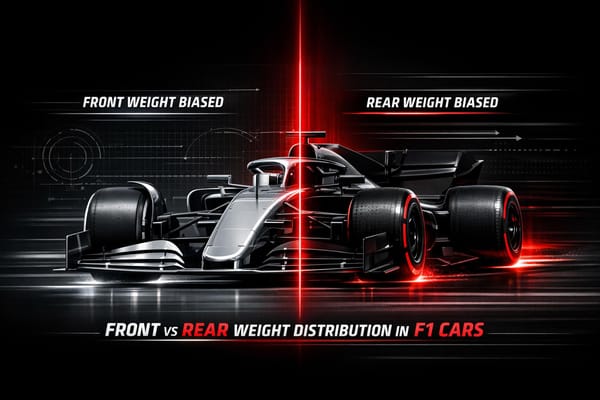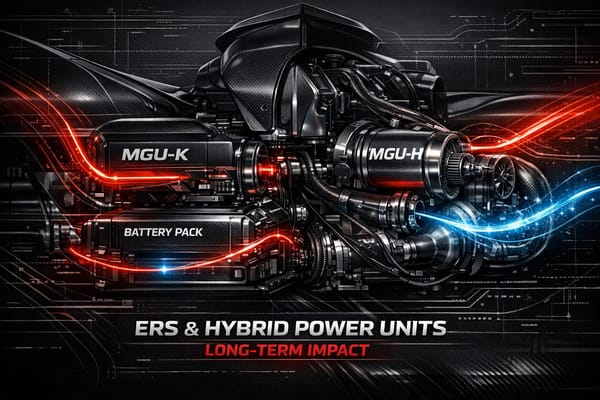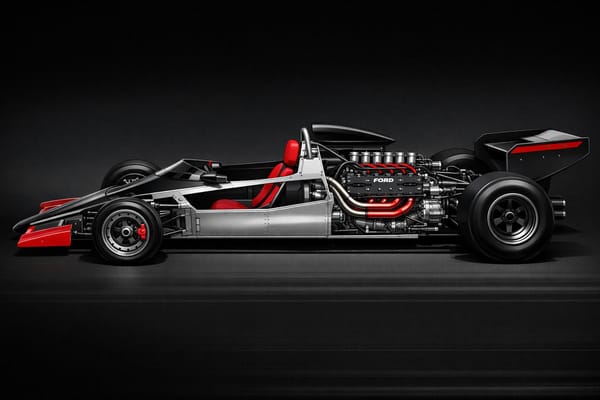Baku’s Risk vs Reward: Is 2025 the Year for a Shock Winner in Azerbaijan?
Baku's unpredictable Grand Prix could crown an unexpected winner in 2025, as strategy, weather, and chaos challenge teams and drivers alike.
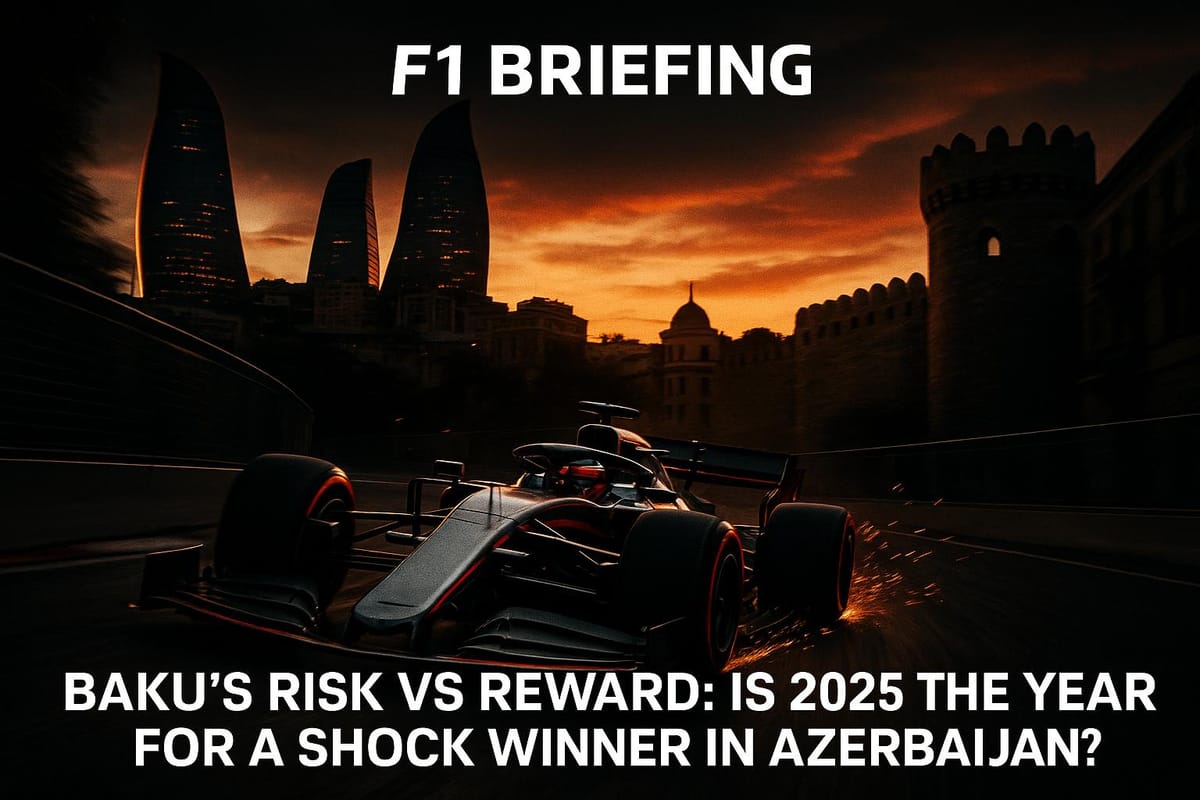
Baku's Azerbaijan Grand Prix is famous for unpredictability. With a 57% chance of a Safety Car, narrow streets, and a mix of high-speed straights and tight corners, the race often delivers unexpected results. Past years have seen surprise winners like Daniel Ricciardo and Oscar Piastri, showing that strategy, quick decisions, and a bit of luck can outshine raw speed. In 2025, with changes in technical regulations and new drivers, the stage is set for another chaotic, thrilling race. Will this year crown another underdog? History suggests it’s very possible.
Ricciardo's Chaotic Baku Win | Extended Race Highlights | 2017 Azerbaijan Grand Prix
Baku City Circuit: Risk Factors vs Reward Opportunities
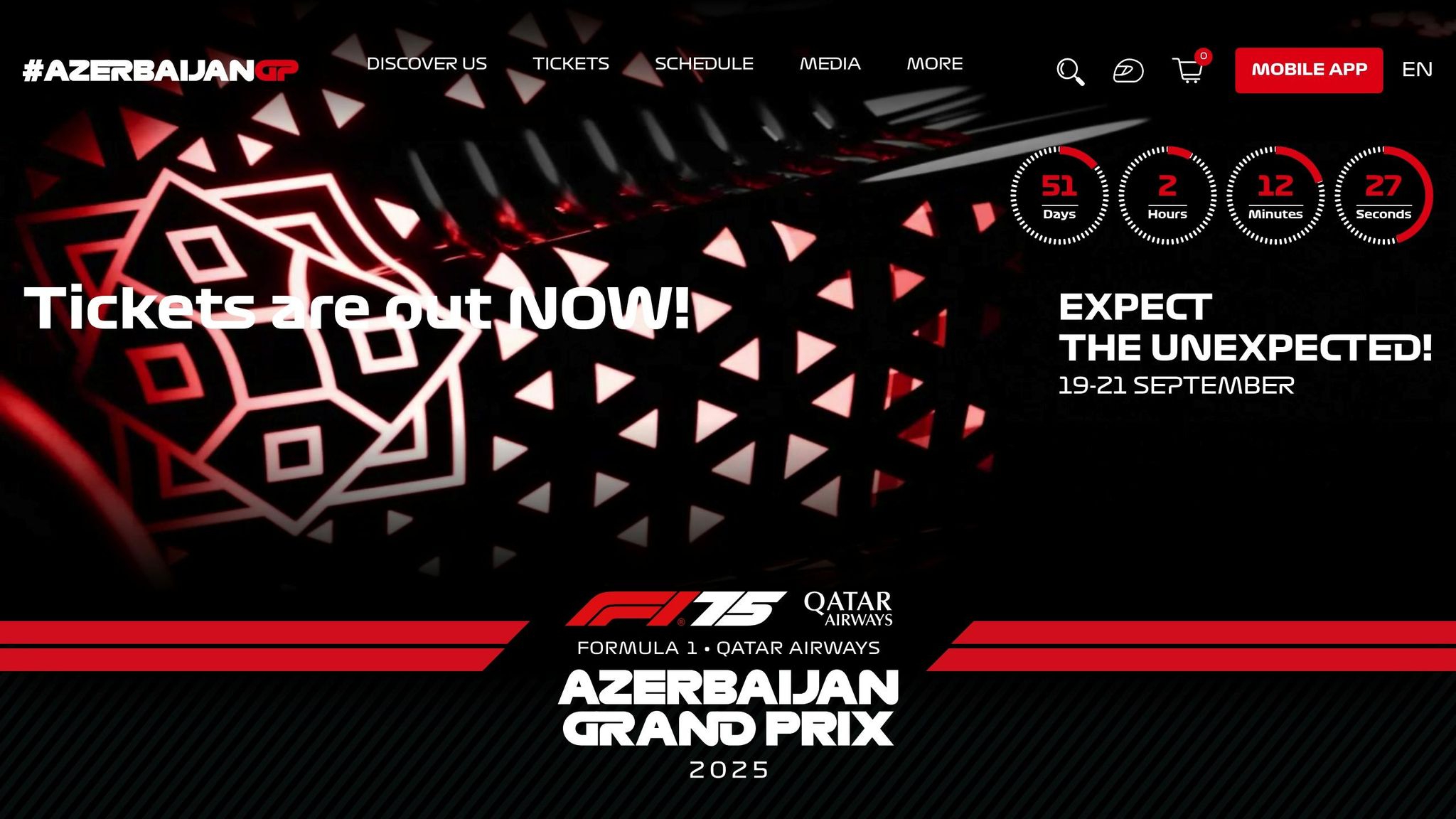
The Baku City Circuit has built a reputation for unpredictability, offering a blend of challenges that demand sharp strategies and quick thinking. Its unique layout and operational quirks create a setting where the line between triumph and disaster is razor-thin. For Formula One teams, understanding these dynamics isn’t just useful - it’s essential for navigating the twists and turns of Azerbaijan’s street circuit.
Track Layout and Key Features
Baku’s circuit is a tale of two extremes. On one hand, you’ve got the blisteringly fast main straight between Turns 2 and 3, stretching 1.37 miles (about 2.2 kilometers). This is where Valtteri Bottas once hit an eye-watering 228 mph in his Williams car. On the other hand, there’s the Castle Complex, a section of narrow, winding corners between Turns 8 and 10 that squeezes down to just 25 feet wide. Even the smallest mistake here can end a driver’s race.
"The street pattern has obviously determined the nature of the track quite a bit, ensuring that the drivers face a number of singular challenges, including the tight 90‑degrees turns that always test their skills to the very limit – just ask Lewis Hamilton!"
This insight from Arif Rahimov, Executive Director of BCC, highlights just how demanding the track is - even for seasoned champions. For less experienced drivers, this pressure-filled environment can sometimes level the playing field, offering them a chance to shine.
Another key feature of the Baku circuit is its relatively low tire abrasiveness. Unlike tracks where tire wear forces teams to play it safe, Baku allows for more aggressive strategies. Drivers can push harder for longer, which opens the door to creative tire and pit stop plans.
Tire Management and Pit Stop Timing
The low tire wear at Baku gives teams a bit more freedom to experiment, but it doesn’t mean strategy is any less critical. A pit stop here costs around 19 seconds, so timing is everything.
A common approach is to start on soft or medium tires and then switch to hards for a one-stop strategy. However, with safety cars appearing in roughly 67% of Baku races, plans often need to change on the fly. For example, while a front-runner like Max Verstappen might stick to a medium-to-hard strategy with a possible third stint on used softs, midfield teams often take bigger risks. A perfectly timed pit stop during a safety car period can completely shuffle the order, giving underdog teams a shot at surprising results.
The challenge lies in balancing aggression with caution. Baku’s layout is unforgiving, and teams must weigh the benefits of pushing hard against the risks of a costly mistake. Add in the unpredictability of the weather and frequent safety car interruptions, and it’s clear why adaptability is key.
Weather and Safety Car Impact
Weather is another wildcard at Baku. Its location near the Caspian Sea means conditions can change in an instant. Shifting track temperatures and unpredictable winds can throw off car balance, especially on the long straights.
Then there’s the ever-present threat of safety cars. With a 67% chance of deployment, safety car periods have a way of leveling the playing field. Teams that can adapt quickly during these moments - whether by pitting for fresh tires or adjusting their strategy - often find themselves in a stronger position. In a race where one crash can completely change the dynamic, being prepared for the unexpected is crucial.
Altogether, these factors make Baku a circuit where bold decisions and quick reactions can lead to surprising outcomes. It’s not just about speed; it’s about strategy, timing, and a bit of luck.
Past Results: Baku's Shock Winners
Since its debut in 2016, the Azerbaijan Grand Prix has been a breeding ground for unexpected outcomes. The street circuit in Baku, with its tight corners and high-risk layout, has consistently created opportunities for surprise podiums and dramatic twists.
Memorable Upsets in Baku
The 2017 Azerbaijan Grand Prix is still remembered for its chaos and unpredictability. Daniel Ricciardo, starting from tenth on the grid, took full advantage of multiple safety car periods to claim an unlikely victory. That same race saw Sebastian Vettel intentionally collide with Lewis Hamilton during a safety car phase, earning Vettel a ten-second stop/go penalty. Amid the turmoil, Lance Stroll secured his first-ever podium finish, showcasing how unpredictable Baku can be.
In 2018, drama struck again when Red Bull teammates Max Verstappen and Daniel Ricciardo collided while fighting for position, removing both from contention. Reflecting on the incident, Red Bull Team Principal Christian Horner remarked:
"We allow them to race, we allow them to go wheel-to-wheel. We discussed in the pre-race meetings about giving each other space and this was the culmination of two guys taking things into their own hands which shouldn't have happened".
The chaos didn’t stop there. Valtteri Bottas looked set for victory until a late puncture handed the win to Lewis Hamilton. Even Hamilton admitted:
"Valtteri really deserved to win and drove an exceptional race".
Fast forward to 2021, and Sergio Pérez emerged victorious after Max Verstappen crashed out due to a tire failure in the closing stages. A rare restart mistake by Hamilton further opened the door for Pérez, while Sebastian Vettel and Pierre Gasly rounded out a surprising podium.
In 2024, Oscar Piastri claimed his first Formula One victory at the Azerbaijan Grand Prix. The young Australian displayed remarkable composure, fending off challenges on the tricky street circuit. Charles Leclerc and George Russell completed the podium.
These moments underline how Baku rewards bold strategies and the ability to adapt to chaos.
Incident Trends and Race Chaos
Baku's reputation for unpredictability isn’t just anecdotal - it’s backed by numbers. There’s a 57% chance of a safety car and a 29% likelihood of a virtual safety car during the race. For instance, in 2024, the penultimate lap saw Carlos Sainz and Sergio Pérez collide while fighting for third place, both crashing into the barriers and retiring.
The track’s unforgiving nature leaves no room for error, especially in its narrow sections. As Williams Racing summed up:
"Baku has earned a reputation for unpredictability, with plenty of drama occurring in the seven races it has hosted".
Statistical Data
The numbers tell the story: in Baku, it’s not just about starting at the front - it’s about capitalizing on opportunities during the race.
| Year | Winner | Key Contributing Factors |
|---|---|---|
| 2017 | Daniel Ricciardo | Safety car chaos and Vettel's penalty |
| 2018 | Lewis Hamilton | Bottas's puncture and a Red Bull collision |
| 2021 | Sergio Pérez | Verstappen's tire failure and Hamilton's mistake |
| 2024 | Oscar Piastri | Defensive driving to secure his first victory |
Pole position offers no guarantees here. Only two drivers - Nico Rosberg in 2016 and Valtteri Bottas in 2019 - have converted pole into a win. Sergio Pérez, however, has emerged as a standout performer on this circuit, becoming the only repeat winner with victories in 2021 and 2023. He also holds the record for the most podium finishes in Baku, with five. To top it off, the 2023 race alone featured 50 overtakes, proving that Baku's layout consistently delivers thrilling, wheel-to-wheel battles.
These historical results set the stage for evaluating the 2025 contenders and the challenges they’ll face at this unpredictable circuit.
2025 Contender Analysis: Favorites vs Underdogs
The 2025 season brings fresh excitement to the Azerbaijan Grand Prix in Baku, a track known for turning expectations on their head. With its mix of long straights and tight corners, the circuit challenges both team strategies and driver skills, making it a true test of adaptability.
Top Teams and Their Baku Strengths
Red Bull Racing heads into 2025 as a dominant force, but Baku’s unique demands could shake things up. The track requires a tricky balance: low drag for the long start/finish straight and enough downforce for the tight, technical sections. Red Bull has proven adept at fine-tuning this balance, but even their recent success doesn’t guarantee an easy win on such an unpredictable circuit.
Ferrari has a strong history at Baku, with Charles Leclerc holding the fastest lap record of 1:43.009, set back in 2019. Their cars are typically designed with high aerodynamic efficiency in mind, which gives them an edge in the technical sections. However, the challenge lies in maintaining that efficiency while ensuring enough straight-line speed and managing tire wear across the varied demands of the track.
Mercedes brings power and precision to the table. Their power unit performance is a significant advantage on Baku’s flat-out 27-second stretch. Add to that their long-wheelbase design, which provides a solid balance between drag and downforce, and their expertise in tire management, and it’s clear they’ll be a force to reckon with.
Meanwhile, the midfield teams are quietly positioning themselves to capitalize on Baku’s penchant for chaos.
Midfield Teams and Potential Dark Horses
While the top teams often grab the spotlight, midfield contenders have the ability to disrupt the status quo, especially on a circuit as unpredictable as Baku.
Williams has shown steady progress and currently ranks 5th in mid-season 2025 standings. Their upward momentum, combined with the strategic flexibility they’ve demonstrated, could make them a serious contender in Baku’s high-risk, high-reward environment.
Racing Bulls, sitting in 6th place, has built a reputation for consistency. This reliability could pay off big in a race where other teams may falter under the pressure of finding the perfect setup.
Alpine, ranked 7th, thrives on unpredictability - something Baku serves in spades. Their knack for seizing opportunities, particularly during safety car periods, makes them a team to watch.
Aston Martin, currently 8th, shouldn’t be overlooked. They’ve shown flashes of brilliance in chaotic races, and with Baku’s history of safety car interventions, they could turn those moments into a strong result with sharp strategy.
Sauber, rounding out the midfield at 10th, has seen encouraging progress under Nico Hulkenberg’s leadership. While a podium finish might seem ambitious, the right circumstances could see them pulling off a surprise result.
Of course, no discussion of Baku would be complete without considering the drivers who excel on street circuits.
Drivers with Street Circuit Experience
Baku is unforgiving, with its narrow streets and minimal run-off areas demanding precision and confidence from drivers. The circuit’s high speeds and overtaking opportunities reward those with both skill and courage.
Sergio Pérez is a standout on street circuits, often emphasizing how these tracks shift the focus back to driver ability. As Miles Goldsack noted:
"Perez recently brought up how street circuits swing more of the balance back to driver skill".
His expertise in managing tire degradation while maintaining competitive pace makes him a constant threat at Baku.
Valtteri Bottas, another seasoned driver, has a deep understanding of Baku’s rhythm. He still holds the unofficial fastest speed record of 378kph from 2016. Even in cars that aren’t championship contenders, Bottas has shown he can deliver standout performances, making him a potential spoiler for the front-runners.
As street circuits become more prominent in Formula 1, drivers with a knack for these unique challenges will only grow in importance. At Baku, it’s the perfect mix of strategic brilliance and driving talent that often determines who stands on the podium.
The 2025 Azerbaijan Grand Prix is shaping up to be a thrilling spectacle. While the favorites bring the horsepower and resources, history shows that Baku often rewards those who can think on their feet and deliver under pressure. It’s anyone’s race to win.
New Approaches and Technical Developments for 2025
The 2025 season introduces fresh strategies and technical updates tailored to Baku's unique challenges - a track that combines high-speed straights with tight, intricate corners. These innovations could shake up the playing field, offering opportunities for teams to outperform expectations.
New Approaches for Risk Management
Teams are adopting cutting-edge analytics to navigate Baku's unpredictable conditions. McLaren's Racing Director, Randeep Singh, highlighted how modern F1 strategies are meticulously planned ahead of race day:
"We establish our strategy weeks in advance by analyzing tire behavior and pit-loss costs. The poorer the tire performance, the more stops you want to make, and the higher the pit loss, the fewer the stops you want to make."
Monte Carlo simulations have become a pivotal tool, capable of predicting lap-time variations under shifting weather conditions. By running thousands of virtual race scenarios, teams can uncover strategic opportunities that traditional methods often miss. Singh elaborated on this approach:
"We run simulations that sweep across different tire behaviors, pit losses, strategies for competitors and ourselves that use a quasi-Monte Carlo method to give us more information about our baseline strategies and about how they may vary."
Another game-changing tool is Bayesian updating, which allows teams to incorporate live data on weather and track conditions. This enables earlier, more precise pit calls. A notable example of where such tools could have been critical was the 2021 Russian Grand Prix. Lando Norris’s decision to stay on slick tires in the rain, while rivals switched to intermediates, led to a costly loss of position. With advanced actuarial tools, a different outcome might have been possible.
Real-time analytics are proving their value, with teams using them to improve response times by as much as 40%. Decision trees now guide pit strategy, turning what once relied on gut instinct into calculated, data-driven decisions. These advancements are particularly promising for midfield teams aiming to disrupt the podium hierarchy.
Technical Developments and Car Setup
Strategic innovations are being complemented by technical refinements, as teams fine-tune their setups to handle Baku's unique demands. The circuit's layout requires balancing low downforce for straight-line speed with sufficient grip for the tight corners, especially along the 2.2 km (approximately 1.37 miles) straight from Turn 16 to Turn 1.
Aerodynamic setups are being adjusted to meet these challenges. Conservative configurations might use settings of 35 (front) and 20 (rear), while more aggressive approaches drop both to 10–15 .
Transmission settings are also critical, particularly in heavy braking zones. Most teams opt for 100% engine braking, with differential settings of around 45% on throttle and 50% off throttle to ensure stability and grip. Some are experimenting with lower on-throttle differential settings to minimize wheel spin in slow corners.
Suspension geometry plays a key role in tire durability and handling. Typical camber angles hover around -3.50° at the front and -2.20° at the rear, while toe angles are kept minimal. A stiff front suspension (around 41) combined with a softer rear suspension (around 5) enhances responsiveness and absorbs bumps effectively.
Braking precision is vital, particularly at Turns 1 and 3. High brake pressure (95%) and a front brake bias of 55% help balance deceleration, while anti-roll bar settings of 18 (front) and 8 (rear) improve curb handling.
Tire pressure optimization is another crucial factor. Front tires are typically set to around 29.5 psi, with rear pressures at 26.5 psi, striking a balance between performance and tire longevity. Softer suspension setups are also being used to reduce wheel spin and improve traction, especially in the castle section's tight confines .
Baku’s relatively flat track allows for low ride heights - typically between 25–55 mm - giving teams more flexibility in their setups. Combined with advanced tire degradation models that consider variables like track temperature and driving style, these adjustments can lead to strategic breakthroughs. For instance, Charles Leclerc's success in the 2024 Italian Grand Prix was largely attributed to a well-executed one-stop tire strategy, demonstrating how refined tire management can outshine raw speed.
Together, these advanced risk management tools and precise technical setups could create opportunities for surprising results at Baku in 2025.
Conclusion: Assessing the Odds of a Shock Winner in 2025
Baku has earned its reputation as one of Formula 1's most unpredictable circuits, where the usual pecking order often gets turned on its head. With six different winners and a rare pole-to-win conversion rate, the Azerbaijan Grand Prix has proven itself as a race where surprises are the norm.
The stats back up this unpredictability. A 57% chance of a safety car combined with the circuit's demanding layout creates the perfect recipe for chaos. The mix of high-speed straights and tight corners challenges teams to find the right balance in car setups, further opening the door for unexpected results.
Looking ahead to 2025, the conditions are ripe for another shock outcome. Betting odds reflect this uncertainty: Lando Norris at +120, Max Verstappen at +750, Charles Leclerc and Oscar Piastri at +500, and Sergio Pérez - Baku's only repeat winner - at +2500. Pérez's victories in 2021 and 2023 highlight how this track rewards opportunism and adaptability over sheer dominance.
History shows that Baku has a knack for delivering surprises. Daniel Ricciardo's unexpected win in 2017 is a prime example of how this circuit rewards seizing opportunities rather than relying solely on qualifying performance. With an average of three different race leaders per event and several races decided by mere seconds, the Azerbaijan Grand Prix consistently provides chances for underdogs to shine.
As teams refine their setups and strategies to handle Baku's unique demands, the stage is set for another unpredictable race in 2025. The combination of advanced risk management, technical precision, and the circuit's chaotic nature makes it a prime venue for yet another surprise winner.
FAQs
Why is the Baku City Circuit known for producing unpredictable Formula 1 races?
The Thrills of the Baku City Circuit
The Baku City Circuit has earned a reputation for delivering some of the most unpredictable races in Formula 1. Its layout combines high-speed straights with tight, technical corners, creating a track that demands precision and nerve. One standout feature is its incredibly long straight, which opens the door for dramatic overtakes, often through slipstreaming. But don’t let that speed fool you - narrow sections and sharp turns leave drivers with little margin for error, frequently leading to crashes or safety cars that can shake up race strategies in an instant.
As if the track’s challenges weren’t enough, external factors like changing weather conditions add another layer of unpredictability. Strong winds and fluctuating temperatures can significantly affect tire wear and car performance, forcing teams to adapt on the fly. This combination of technical hurdles and environmental twists makes Baku a stage where anything can happen, keeping fans and drivers alike on the edge of their seats.
How does the safety car impact race strategies at the Azerbaijan Grand Prix?
The safety car holds a key role in influencing race strategies during the Azerbaijan Grand Prix. When it’s deployed, the race flow is interrupted, prompting teams to make swift calls on tire changes and pit stop timing. For example, some drivers might opt for harder tire compounds during this window to stretch their stints, while others might tweak their plans to secure better track position.
In a race as unpredictable as Baku, the safety car can shake things up dramatically. It often levels the field, giving underdog teams a shot at outperforming expectations while forcing leading teams to rethink their strategies mid-race. This element of surprise makes sharp timing and adaptable strategies essential for navigating the demanding Baku City Circuit.
Which teams and drivers could thrive in Baku’s unpredictable 2025 race?
Baku’s Thrilling Street Circuit
Baku’s street circuit is a fascinating blend of tight corners and high-speed straights, creating a stage where both top teams and underdogs can shine. Red Bull Racing and Mercedes are expected to be strong competitors here, leveraging their technical expertise and ability to adapt to challenging conditions. With drivers like Max Verstappen and Lewis Hamilton, who are masters of handling pressure and executing bold race strategies, these teams are well-prepared to navigate the circuit’s unpredictable nature.
But here’s the twist - Baku’s chaos doesn’t just favor the big names. The circuit’s unpredictable dynamics often allow mid-tier teams to step into the spotlight. With smart tire strategies and a knack for spotting overtaking opportunities, underdog drivers have a real shot at shaking things up. This unpredictability is what makes the 2025 Azerbaijan Grand Prix a must-watch event, as it could completely change the standings in unexpected ways.

